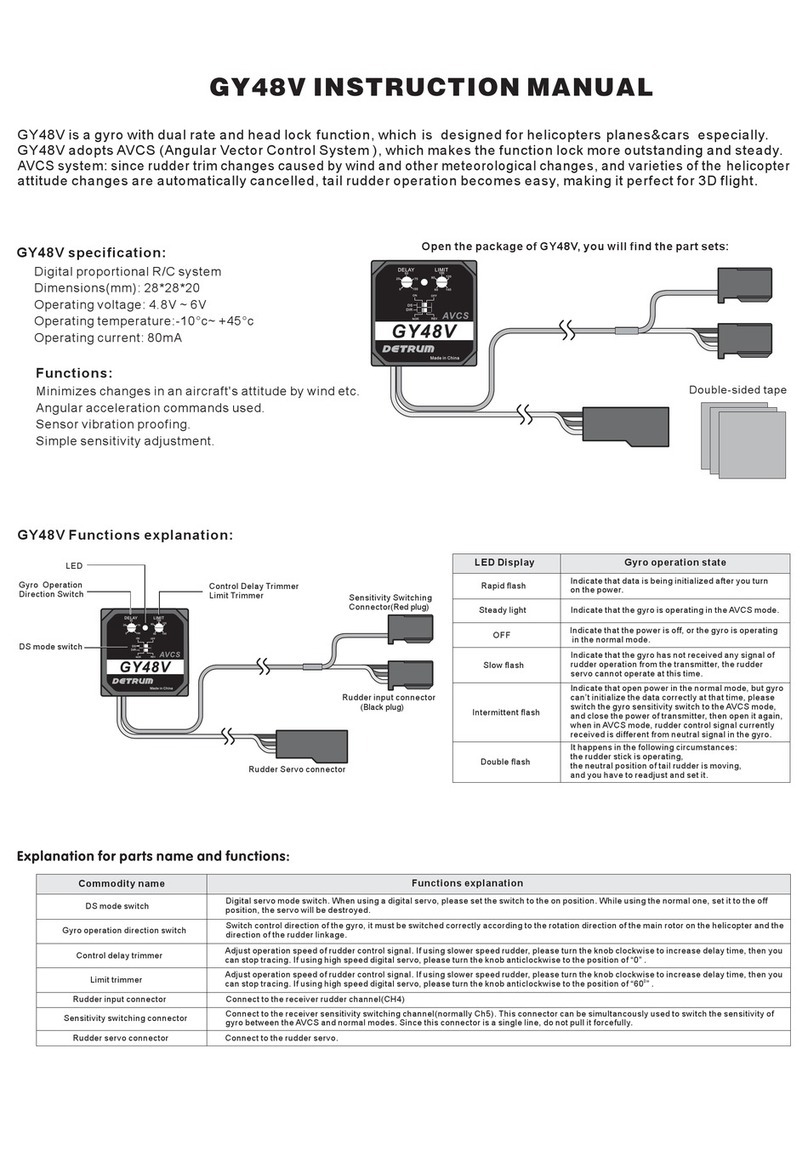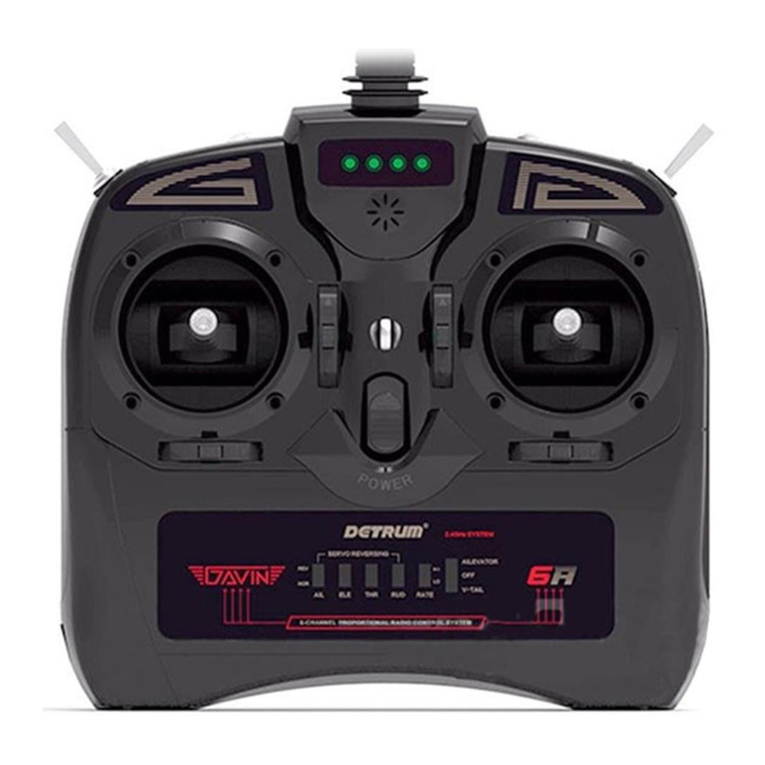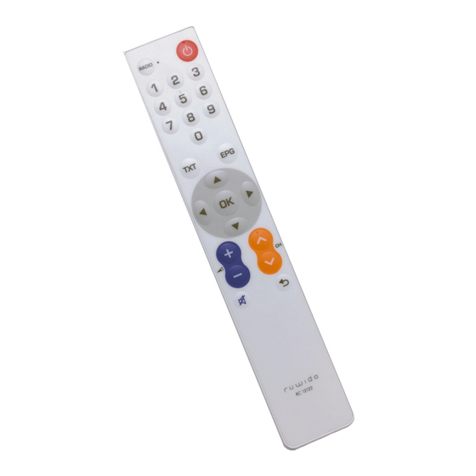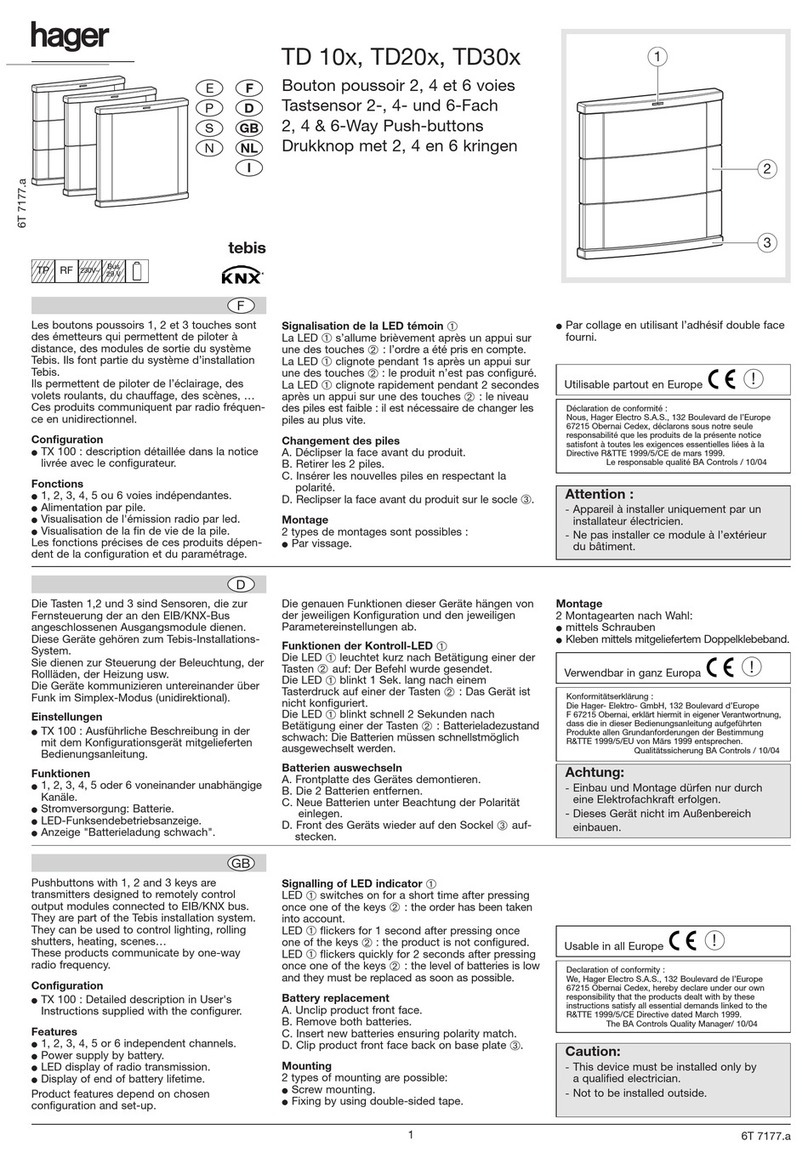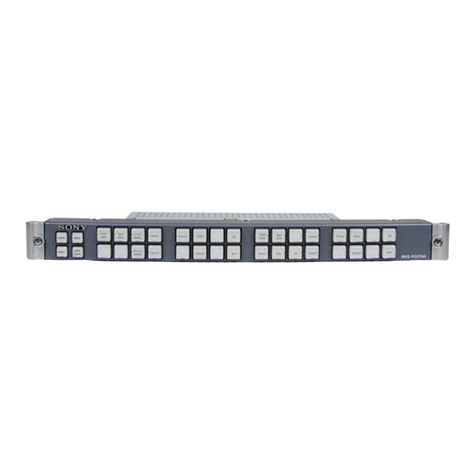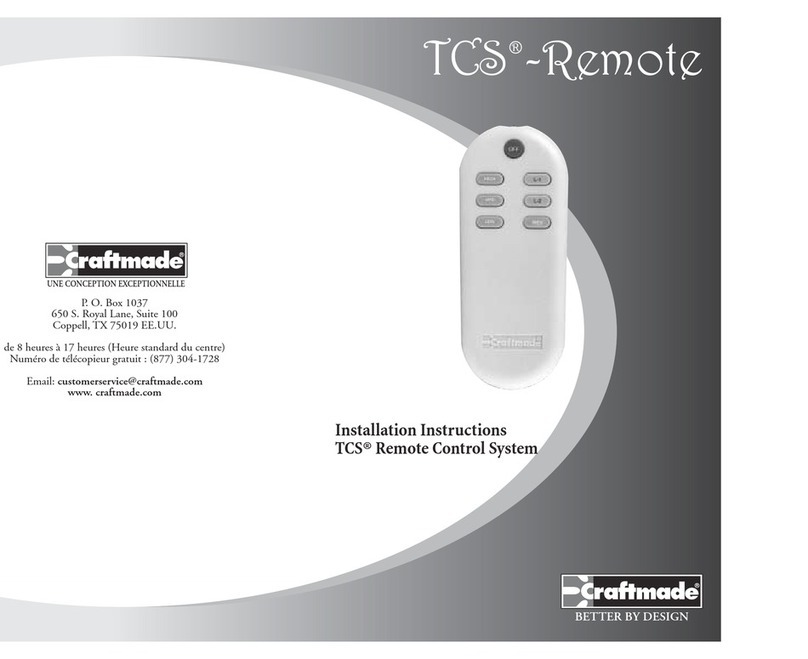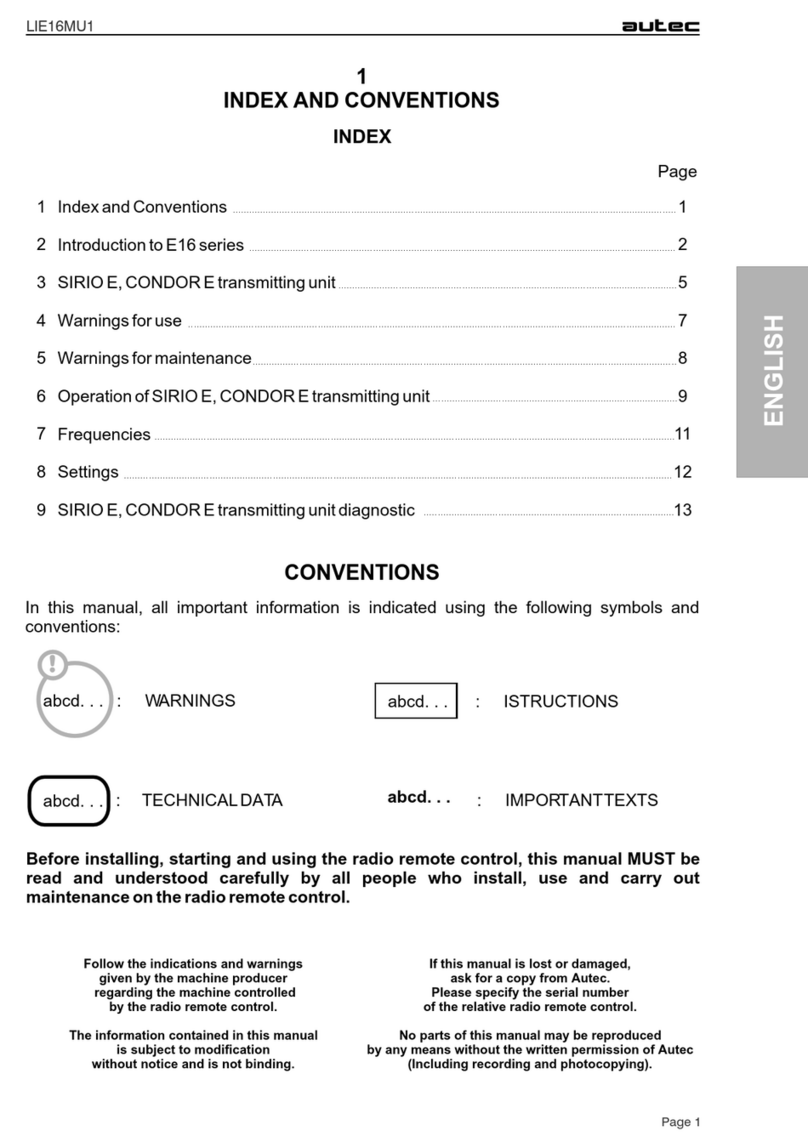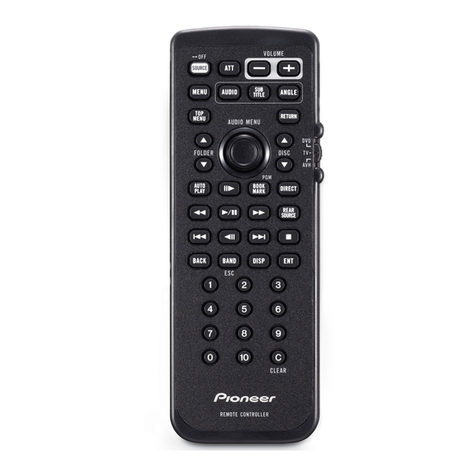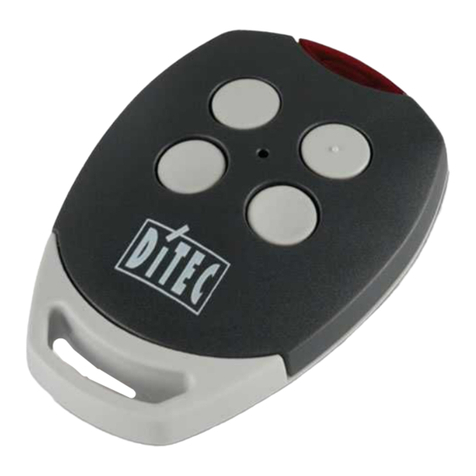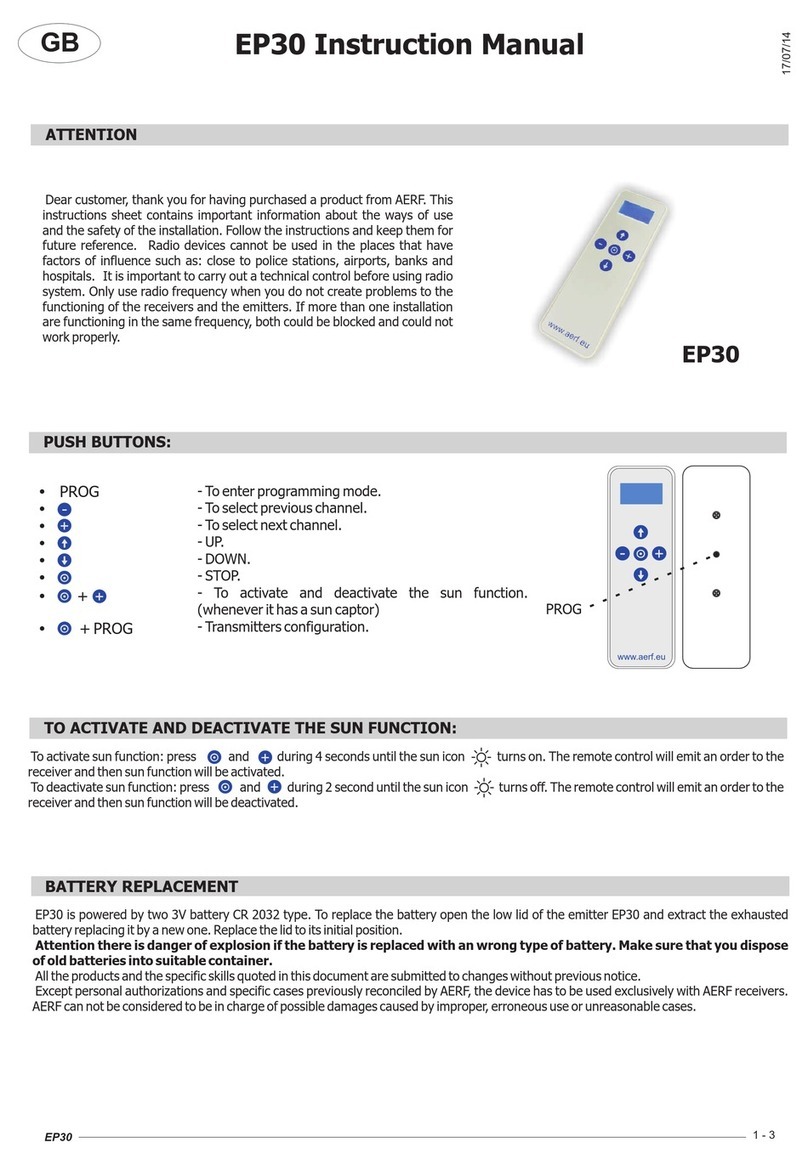DETRUM Blitz-DT9 User manual

- I -
TABLE OF CONTENTS
Foreword .........................................1
Disclaimer.........................................1
Change History.................................1
Indications and Symbols for Safe Use
..........................................................1
Installation Precautions....................1
Flying Precautions............................2
Product Description.......................5
Box Contents....................................5
Transmitter........................................5
Specifications..............................5
Features......................................5
Transmitter Controls ...................6
Main Screen................................8
Receiver ...........................................9
Specifications..............................9
Features......................................9
Changing the signal mode........10
Connection................................10
Receiver Firmware Upgrade.....11
Basic Operation............................13
Adjust the Stick Lever Tension.......13
Turn on/off the Transmitter.............13
Charging the Transmitter................14
Binding............................................14
Range Test .....................................15
Flight Mode.....................................16
Firmware Update............................16
Programming Voice/Vibration
Alerts .............................................17
Model Type....................................19
Model Set ......................................20
Select Model [Model Select]...........20
Edit Model Name [Model Name]....21
Stick Mode [Stick Mode].................21
Trainer Set [Trainer Set].................22
Channel Input Set [Channel Set] ...24
Import & Export ..............................25
Export Model.............................25
Import Model.............................25
Export All Model........................26
Import All Model........................27
Fail Safe [Fail Safe]........................27
Reset Model [Reset Model]............28
Model Parameter (Airplane) ........30
End Point [End Point].....................30
Sub Trim [Sub Trim]........................31
Reverse [Reverse]..........................31
Servo Delay [Servo Delay].............32
Switch Set [Switch Set]..................33
Throttle Hold [THR Hold]................34
Mix Set [Mix Set] ............................35
Programmable Mixing [Program
Mix]............................................35
Throttle to Balance Mixing [THR→
BAL Mix]....................................36

- II -
Veer to Elevator Mixing [Veer→
ELE Mix]....................................37
V-tail Mixing [V-Tail Mix]............39
Delta Mixing [Delta Mix]............40
Flaperon Mixing [Flaperon Mix] 42
Aileron Curve [AIL Curve]...............44
Elevator Curve [ELE Curve]...........45
Throttle Curve [THR Curve] ...........45
Rudder Curve [RUD Curve] ...........46
RS/LS/R KNOB/L KNOB Curve [RS/LS/R
KNOB/L KNOB Curve]
.......................46
Model Parameter (Helicopter) .....48
End Point [End Point].....................48
Sub Trim [Sub Trim]........................48
Reverse [Rev Set] ..........................48
Servo Delay [Servo Delay].............48
Switch Set [Switch Set] ..................48
Throttle Hold [THR Hold]................49
Swash Mixing [Swash Mix].............49
Pitch Curve [PIT Curve]..................51
Aileron Curve [AIL Curve]...............52
Elevator Curve [ELE Curve]...........52
Throttle Curve [THR Curve] ...........52
Rudder Curve [RUD Curve] ...........53
RS/LS/R Knob/L Knob Curve [RS/LS/R
Knob/L Knob Curve]
.........................53
Function Set..................................54
Timer Set [Timer 1/2 Set]...............54
Downlink History [Downlink History]
........................................................56
Airplane Gyro .................................56
ESC Set..........................................61
Channel Monitor...........................63
System Set....................................64
Language [Language]....................64
PPM Set [PPM I&O].......................64
Back-light Time [Bright Off] ............64
Back-light Brightness [Brightness].65
Vibration [Vibration]........................65
Volume [Volume] ............................65
Calibration [Calibration]..................66
About Information [About] ..............66

- 1 -
Foreword
Disclaimer
Thank you for purchasing this DETRUM product. This is a 2.4GHz digital
proportional R/C system with high performance. In order to make full use of the
features of this product and to safely enjoy your R/C activities, please read this
manual carefully before using. Please install and use this product in strict
accordance with the manual. The company assumes no liability or loss incurred
directly or indirectly from improper use, installation, or any modification of this
product.
Products shall be subject to any changes without additional notices.
This product is suitable for users experienced in operating model aircraft and
aged 14 years or older.
Please fly at a locally recognized model aircraft flying field.
Change History
No.
Version
Date
Records
1
V1.0
2018-03-20
This manual was first released.
2
V1.1
2018-06-20
Update the figures.
Indications and Symbols for Safe Use
The following symbols used in this manual indicate the precautions regarding
possible danger which may occur following improper operation.
DANGER: Procedures, which if not properly followed, may lead to a
dangerous condition of death or serious injury.
WARNING: Procedures, which if not properly followed, may lead to the
probability of property damage, collateral damage, and serious injury OR
create a high probability of superficial injury.
CAUTION: Procedures, which if not properly followed, may lead to the
probability of physical property damage AND a possibility of serious injury.
Prohibited Mandatory
Installation Precautions
It is very important to properly install the R/C system on the model aircraft.
Please refer to the following instructions:

Blitz-DT9 User Manual
- 2 -
In order to protect the receiver, wrap the receiver with 10mm foam rubber,
and then fasten it with a rubber band or a Velcro strap.
The servos should be installed with rubber gaskets and brass eyelets to
isolate the vibration from the fuselage. When locking the screws, follow the
principle that the rubber gasket does not distort. If the locking is too tight, it
will reduce the vibration-proof performance.
When mounting a servo, make sure that the servo can rotate over its full
travel and check that the push-rods and servo arms do not bind or contact
each other.
When mounting a power switch, keep away from the engine's exhaust pipe
and any places with high vibration. And ensure that you can turn the switch
on/off without binding.
The two antennas of the receiver should be placed at 90 degrees to each
other. Do not place the two antennas twisted together or in parallel.
Flying Precautions
WARNING: Personal injury and property loss may be caused by improper
aircraft handling. Please operate strictly according to the following safety
instructions.
Flying Field and Conditions:
In order to protect the personal safety and their property, please do not fly at
the following places:
Near another radio control flying field
Near or above people
Near residential areas, schools, hospitals or other places where people
congregate
Near high-voltage lines, tall buildings, or communication facilities
Never fly on rainy day, thunder storm, when the wind is strong, and at night.
Always keep away from humidity environment.
The R/C system is composed of precision electronic components and
mechanical parts. Please keep away from humidity environment to prevent
the components damage from vapor and cause a failure which would lead to
a crash.
Always keep away from heat sources.
The R/C system is composed of precision electronic components and
mechanical parts. Please keep it away from heat sources and sunshine to
avoid distortion, or even damage caused by high temperature.

Blitz-DT9 User Manual
- 3 -
Precautions before Flight:
Always make sure that all servos in the model work properly following the
transmitter stick movements prior to flight. And make sure that all switches
work properly as well.
Always check the remaining capacity of both the transmitter and receiver
batteries before each flying session prior to flight. Low battery capacity will
cause loss of control and a crash.
Always perform a range test before each flying session.
Always check the operation of each control surface before each flying session.
When using the trainer function, please check both the instructor and student
transmitters.
For safety reasons, always set fail safe functions before each flying session.
Especially set the throttle channel fail safe function.
Precautions during Flight:
Never grasp the transmitter antenna during flight. Otherwise, the transmitter
output power will reduce drastically.
Do not point the antenna directly toward the aircraft during flight. When
pointing the antenna directly, the transmitter output is the weakest. The
strong radio wave radiate from the side of the transmitter antenna.
Never turn on and off the power switch of transmitter during flight or while the
engine or motor is running.
Do not touch the engine, motor, or other heating device during and
immediately after use. These devices or components may become hot during
use.
For safety, always fly the aircraft in visible range. Flying behind tall buildings
will not only lose sight of the aircraft, but also degrade the RF signal
performance.
Always return the transmitter setting screen to the initial main screen during
flight. Erroneous input during flight is very dangerous.
Precautions in Other Conditions
Never fly in the range check mode (test mode). In this mode, the transmitter
output power is greatly reduced, it may cause a crash.
When setting the transmitter during flight preparations, do not set it upright on
the ground. The transmitter may fall to the ground, the sticks may move and
the servos may rotate unexpectedly and cause injury.
Do not touch the receiver antenna directly by hands. Otherwise, the
components may be damaged by static, and this may cause a reduction in
transmission distance of the receiver.
Before turning on the transmitter, always make sure the transmitter throttle

Blitz-DT9 User Manual
- 4 -
stick and throttle trim are in the lowest position.
Always turn on the R/C system in proper sequence: turn on the transmitter
first, then turn on the receiver, and then turn on the engine or motor. Incorrect
sequence may cause loss of control and personal injury.
Always turn off the R/C system in proper sequence: turn off the engine or
motor first, then turn off the receiver, and then turn off the transmitter.
Incorrect sequence may cause loss of control and personal injury.

- 5 -
Product Description
Box Contents
Blitz-DT9 Transmitter Detrum RXC9M Receiver
User Manual Charging Cable
Simulator Convertor (optional) 9g Servo *4pcs (optional)
NOTE: The set contents depend on the type of set.
Transmitter
Specifications
Number of Channels
9
Modulation / Protocol
DSSS&FHSS
Band
2.4GHz
Frame Rate
2.6ms
Telemetry
Yes
Voice Alerts
Yes
SD Card Support
Yes
Upgradeable Firmware
Yes
Trainer System
Yes (both wired and wireless)
ESC Parameter Setting Support
Yes
Stabilized Receiver Setting Support
Yes
Black Box
Yes
Built-in Charging Module
Yes
Battery
7.4V 3000mAh Li-Po (included)
Charging Voltage
DC 12V/1.5A
Consuming Current
< 300mA
Size
204×246×122mm
Net Weight
693g (w/o battery) /834g (w/ battery)
Features
Adopting powerful wireless chips and extended with power amplifier (PA) and
low noise amplifier (LNA), can maximize the system output power while
reducing the system noise factor, thereby improving the signal coverage.
The R/C system adopts 2.4GHz direct sequence spread spectrum (DSSS)
and multiple frequency-hopping spread spectrum (FHSS) technology, has
strong anti-interference capability, can support a stable remote control for
more than 1,000 meters on the ground and more than 1,600 meters in the air.

Blitz-DT9 User Manual
- 6 -
The aircraft performance data can be displayed on the transmitter screen with
corresponding receiver.
It has 9 channels and can support more functions.
Wireless trainer brings more convenience to instructor and student.
It adjusts the program items of ESC directly without program card.
When working with a stabilized receiver which is integrated with 6-axis gyro,
Blitz-DT9 can be used to set its programmable items in real time.
Low voltage alarm: Detecting the input voltage of the transmitter in real time,
it will alarm in advance when it is low battery voltage. This will bring greater
security for flight operation.
User can charge the transmitter via the matched charging cable even in flight.
Fail safe protection: Set the failsafe function by transmitter in advance. When
the aircraft flies out of range, the receiver cannot receive a valid RF signal
from the transmitter and will move the servos to predefined position.
Upgrade via SD card: Copy the latest program to the SD card, then you can
upgrade the Blitz-DT9 transmitter directly on the menu.
Transmitter Controls
Antenna
Switch (SA)
Switch (SB) Switch (SC)
Switch (SD)
Elevator Stick
Rudder Stick Aileron Stick
Throttle Stick
Digital Trim (Throttle)
Digital Trim (Aileron)
Digital Trim (Elevator)
Digital Trim (Rudder)
Scroll Wheel
Loudspeaker
Clear Key
Back Key
Power switch
Neck strap attachment LCD Display
Switch (SE,SG) Switch (SF,SH)
L Knob R Knob
L trim R trim

Blitz-DT9 User Manual
- 7 -
NOTE: When the Stick Mode is set to MODE 1, the positions of sticks and
digital trims are shown in the figure. The positions are different depending on
the stick mode. For details, please refer to Stick Mode [Stick Mode] (Page
21).
Antenna: the strong radio wave radiate from the side of the transmitter
antenna. Do not point the antenna directly toward the aircraft during flight.
Handle: the handle is designed for easily carrying and placing the transmitter.
Power switch: Push the switch rightward to turn on the transmitter, push
leftward to turn off.
Neck Strap Attachment: for a long flight you can choose to use a neck strap
for easy handing. The neck strap attachment is on the neutral position, in
order to get the best balance for transmitter.
Switches
SA: 3 positions, alternate, short lever.
SB: 3 positions, alternate, long lever.
SC: 3 positions, alternate, long lever.
SD: 3 positions, alternate, short lever.
SE: 3 positions, alternate, short lever.
SF: 3 positions, alternate, short lever.
SG: 2 positions, momentary, long lever.
SH: 2 positions, alternate, long lever.
Sticks: when the Stick Mode is set to MODE 1, the positions of sticks are

Blitz-DT9 User Manual
- 8 -
shown in the figure.
Digital Trims
Stick trims: four digital trims for stick output.
L/R trims: two digital trims for L/R knob output.
This transmitter is equipped with four stick trims. Each time you press a trim
button, the trim position moves one step. If you press and hold it, the output
will scroll in that direction until the trim button is released or the output
reaches its ends. You can always monitor trim positions by referencing the
LCD screen.
CAUTION: The trim positions you have set will be stored in memory and
will remain there even the transmitter powered off.
L/R Knob: It is used to adjust the value of L/R Knob curve.
LS/RS Wheel: It is used to adjust the value of LS/RS curve.
Keys
<CLEAR>: press it to return a selected value on screen to the default
setting.
<BACK>: press it to return to the previous menu.
Scroll Wheel: Scroll it to move through the screen content or change
programming values. Press it to make a selection.
LCD: You can get the current status from the main screen, and set the
parameters from the menu.
Simulator/Trainer Connector
When it is used as a simulator connector, connect the transmitter and
computer by simulator dongle and dongle cable, and then you can learn
flying skills on computer. In order to use this function, you need to purchase
a simulator dongle and the matched simulation software.
When it is used as a trainer connector, connect the instructor and student
transmitter with an optional trainer cable, and then a skilled instructor can
teach a student with flying skills.
Audio Jack: insert the earphone for voice broadcast.
Charge Port: charging the transmitter via the matched charge cable.
SD card slot: press the SD card into it.
Main Screen
Turn on the power switch of the transmitter and directly enter the main screen.

Blitz-DT9 User Manual
- 9 -
. .
0%
00:00
00:00 MODEL01
NORM 00:00:57 45% Battery Indicator
System Timer
Model Type
Throttle Trim
Model Name
L Trim
Timer(1,2)
Elevator Trim
Flight Mode
R Trim
Rudder Trim
Current Position
(Based on the standard
servo movement)1.
2.
.... Aileron Trim
Note:
When the Stick Mode is set to MODE 1, the positions of trims are shown in
the figure.
For details about the flight modes, please refer to FlightMode(Page16).
Receiver
This section is the introductions of DETRUM RXC9M Receiver. If you choose
other receivers, please refer to the instructions of the other receivers.
Specifications
Parameters
RXC9M Specifications
Type
2.4GHz, 9-channel receiver
Sensitivity
-97dBm
Frequency interval
larger than or equal to 4MHz
Power supply
3.6V~16V
Weight
10g
Size
42.6mm*27.4mm*12.9mm
Features
Adopting 2.4GHz direct sequence spread spectrum (DSSS) and multiple
frequency-hopping spread spectrum (FHSS) technology, the receiver has
high sensitivity and strong anti-interference capability.
By using diversity antenna, can automatically switch the signals to ensure the
stability of the received signal.
Each transmitter has an individually assigned, unique ID code. Once the
binding is made, the ID code is stored in the receiver and no further binding is
necessary after restarting the receiver.
When the aircraft flies out of range, the receiver cannot receive a valid RF
signal from the transmitter and will move the servos to predefined position.
Working with the optional telemetry module and sensors, RXC9M can

Blitz-DT9 User Manual
- 10 -
transmit the aircraft performance data to the transmitter.
Support PPM, PWM and D.BUS signal.
USB upgrade: Upgrade by a USB cable help RXC9M always keeps the latest
program.
Changing the signal mode
According to the output signal types, RXC9M has a PPM mode, PWM mode and
D.BUS mode. You can check the current mode from the mode LED on the
receiver. When the RXC9M receiver powers up, the mode LED indicator will glow
solid red/green/blue, and will be off after 5 seconds. When the mode LED is off,
you can light this LED by clicking the Bind/Mode button.
Green: The receiver works on PWM mode.
Red: The receiver works on D.BUS mode.
Blue: The receiver works on PPM mode.
Users can change the receiver mode according to their demands. Now changing
the receiver mode from PPM to D.BUS mode is taken as an example.
Press and hold the Bind/Mode button on the receiver, then power on the
receiver. The mode LED will stay blue (PPM mode) for 2 seconds and then
change into red on, indicating that the receiver switches to D.BUS mode, and the
mode LED will be off 5 seconds later.
Connection
The channels of Detrum RXC9M receiver are labeled with number, as shown in
the following figure. For each channel, signal wire is close to the decal of the
receiver, middle is the positive and right is GND.
The RXC9M receiver has PPM, PWM and D.BUS modes. The connection of the
receiver in these three modes is described as follows:
On PWM mode, you can connect the receiver’s channels directly to the servo,
or connect them to the servos via the flight controller.
Aileron
Elevator
Throttle
Rudder
Gear
AUX1
AUX2
AUX3
AUX4
GND
+
Signal
PPM/D.BUS Channel
Telemetry Port
Bind/Mode Button

Blitz-DT9 User Manual
- 11 -
On PPM mode, connect the PPM port of the flight controller which supports
PPM signal to the PPM/D.BUS port of the receiver, and then connect the
output port of the flight controller to the servos.
On D.BUS mode, connect the D.BUS port of the flight controller which
supports D.BUS signal to the PPM/D.BUS port of the receiver, and then
connect the output port of the flight controller to the servos.
In order to transmit the flight data to the transmitter, user need to connect the
telemetry port of the receiver to the flight controller. When working with optional
telemetry module and sensors such as GPS, RXC9M can transmit the battery
voltage, flying distance, flying speed and flight time, etc.
NOTE: In order to use this function, the flight controller and transmitter you
used should also have telemetry settings.
Installation Precautions for the receiver:
When connecting the receiver, please note the line sequence and securely
insert all of the connectors as far as they will go.
The two antennas of the receiver should be placed at 90 degrees to each
other. Do not place the two antennas twisted together or in parallel.
Receiver Firmware Upgrade
User can upgrade the RXC9M online via the USB port.
Preconditions:
The DetrumUpgrade software has been acquired and installed.
The RXC9M device driver “RXC9M.inf”has been acquired and installed.
The latest upgrade program has been acquired.
Steps:
1. Double-click the DetrumUpgrade software to open it.

Blitz-DT9 User Manual
- 12 -
2. Click the Select button, set the path of this upgrade program in the pop-up
dialog.
3. Power on the RXC9M receiver and connect the receiver to computer via the
USB cable
If the computer cannot recognize the RXC9M when it is connected, you need
to install the RXC9M device driver first. Installation method: (1) Right-click
Computer, select Properties →(2) Select Device Manager, found RXC9M
in the list →(3) Right-click to select Update Driver Software →(4) In the
pop-up dialog box, select Browse my computer for driver software →(5)
Select the file path where the RXC9M device driver is located and click Next.
4. Ensure the information (firmware and product) is right and then click Upgrade
to complete the firmware upgrade.

- 13 -
Basic Operation
Adjust the Stick Lever Tension
This allows adjustment of the stick lever tension to meet different operating
habits.
Tools: Phillips screwdriver, ESD wrist strap or ESD gloves.
Conditions: Before operating, please wear an ESD wrist strap or ESD gloves.
Steps:
1. Open the battery cover, and remove the batteries.
2. Remove the six screws on the rear cover with a Phillips screwdriver.
3. Open the rear cover.
CAUTION: Please gently ease off the transmitter's rear cover, to avoid
breaking the wirings.
Screw for spring adjustment
Screw for spring adjustment
Screw for spring adjustment
Screw for spring adjustment
4. Use a Phillips screwdriver to adjust the spring strength as you prefer by
turning the screw of the stick you want to adjust. Turning the screw clockwise
increases the tension, counter clockwise to loosen.
CAUTION: To avoid abnormal work, do not loosen the screw too much.
5. Install the rear cover, and then tighten the six screws on the rear cover.
6. Install the batteries and the battery cover.
Turn on/off the Transmitter
Turn on the transmitter:
1. Move the throttle stick to the lowest position before turning on the power
switch.
2. Push the power switch rightward to turn on the transmitter.

Blitz-DT9 User Manual
- 14 -
After power on, you will see the initialization interface in LCD as the following
figure. The transmitter's LED indicator stays illuminated at the same time.
Wait for about 2 seconds, the LCD will enter the main screen.
If the throttle stick is not at the lowest position, after turning on the power
switch, the LCD will display the prompt information. Lower throttle stick to the
lowest position, the information will disappear and the LCD will enter the main
screen.
Turn off the transmitter:
1. Turn off the power switch, the transmitter shut down at once.
Charging the Transmitter
Blitz DT-9 has an internal charger designed to charge the battery. The charge
port is on the right side of the transmitter.
Steps:
1. Connect the charge cable to the transmitter charge port.
2. Connect the other end of charging cable to a power outlet using the
appropriate adapter.
Charging the transmitter when it is off, the LCD display will show charging
status and the current battery level. Charging the transmitter when it is on, the
battery level will be showed in the top right corner of the main screen.
User still can operate the transmitter on charging process.
3. Disconnect the charging cable when the battery is full charged.
Binding
In order for the transmitter and receiver to communicate, it is essential to pair or
bind them together. When you use the R/C system first time or change a
transmitter/receiver, this procedure is necessary. Each transmitter has an
individually assigned, unique ID code. Once the binding is made, the ID code is
stored in the receiver and no further binding is necessary after restarting the
receiver.
Preconditions:

Blitz-DT9 User Manual
- 15 -
Move the throttle stick to the lowest position and make sure the transmitter is
powered off.
Place the transmitter and the receiver close to each other within a distance of
about one meter.
Steps:
1. Power on RXC9M receiver. The status LED will start fast red flashing,
indicating the transmitter is off.
2. Long press (more than 2 sec) Bind/Mode button, the status LED will start
slow red flashing, indicating the receiver is in bind mode and ready to be
bound to the transmitter.
3. While pulling and holding the SG switch of transmitter, turn on the transmitter.
The system begins to bind.
4. Once the status LED on the receiver stays green, indicating the receiver is
bound to the transmitter. Release the SG switch.
5. Turn off the transmitter and receiver.
Range Test
It is extremely important to perform a range check before each flying session.
This enables you to ensure that each function is working as it should be.
Blitz-DT9 transmitter allows you to reduce its power output and access the test
mode. Then you can detect interference from environment and perform a range
check.
Steps:
1. Lower throttle to the lowest position and make sure the transmitter is powered
off.
2. While pressing CLEAR key, turn on the transmitter, the transmitter will access
the test mode.
The LCD will display as the following figure, and the transmitter's LED
indicator will flash on test mode.
Rf Link Test
Test...
3. With the test mode on, walk away from the model while simultaneously
operating the controls. Have an assistant stand by the model to confirm that

Blitz-DT9 User Manual
- 16 -
all controls are completely and correctly operational. You should be able to
walk approximately 30~50 paces from the model without losing control.
WARNING: Never fly in range check mode (test mode).
Flight Mode
The flight mode function allows switching between various aircraft flight
characteristics (flight mode) using a switch. The flight modes which can be
selected are various with model type.
Airplane flight mode: NORM (normal) and HOLD (hold).
Helicopter flight mode: NORM (normal), HOLD (hold), and ACR (acrobatic).
It is possible to activate these flight modes by the throttle hold switch and
acrobatic flight switch:
You can change between normal and throttle hold flight mode by toggling
throttle hold switch. The switch can be customized, please refer to Throttle
Hold [THR Hold] (Page 34) for airplane and Throttle Hold [THR Hold] (Page
49) for helicopter.
You can change between normal and acrobatic flight mode by toggling
acrobatic flight switch. The switch can be customized, please refer to Switch
Set [Switch Set] (Page 48) for helicopter.
Firmware Update
You can put the firmware in the SD card and update the Blitz-DT9 by the SD
card.
NOTE: Before installing the upgrading files, always export all models (refer
to Page 25) to an SD card separate from the SD card containing the update.
The update may erase all model files.
Precondition: Download the latest firmware into the root directory of the SD card.
Steps:
1. Press and hold the scroll wheel while turning on the transmitter, it will read the
update automatically and install the firmware into the transmitter.
2. When the update is completed, the interface will go to the calibration interface
automatically.
3. After completing the calibration, the interface will go to the initialization
interface automatically.

- 17 -
Programming Voice/Vibration Alerts
You can program voice alerts to report telemetry information on demand. If an
alarm goes off, you won’t have to look at the transmitter display to see what's
happening and just keep your eyes on what’s you’re flying. You can also set
vibration alert for alarm conditions.
Setting Method:
1. On the main screen, press CLEAR button to enter the telemetry data
interface, as shown in the figure below.
The icons are described in the table below.
Flight No.
RSSI (Received Signal
Strength Indicator)
GPS (unlocked/locked/not connected)
Voltage
Speed
Altitude
Distance
Flight Mode
Rudder
In this interface, you can program voice/vibration alerts for the parameters of
GPS, Voltage, Speed,Altitude, and Distance.
2. Take the Distance setting as an example.
(1) Roll the scroll wheel to select the Distance icon, then press the scroll wheel
to enter the setting interface, as shown in the figure below.
Distance Set 1/3
1.Distance Alert:
2.Distance Max:
3.Distance Min:
OFF
0
0
(2) Roll the scroll wheel to select the parameter, press and then roll the scroll
— — — — — — — — dBm
— — — — — — v
— — — — — — m— — — — — — m
— — — — — — m/s
— — — — — — — — — — — —°

Blitz-DT9 User Manual
- 18 -
wheel to set the value of the parameter. After that, press the scroll wheel to
save the value.
Distance Alert: It is used to set the alert mode.
Values:
OFF: Turn off this alert.
Both: When the distance exceeds the set maximum or minimum values,
both voice and vibration alerts are provided.
Voice: When the distance exceeds the set maximum or minimum values,
voice alert is provided.
Vibra: When the distance exceeds the set maximum or minimum values,
vibration alert is provided.
Distance Max: It is used to set the upper limit of the distance alert.
Distance Min: It is used to set the lower limit of the distance alert.
3. Press the CLEAR button on the interface shown in step 1, it will access to the
following interfaces.
In these interfaces, you can check the telemetry data. The description of each
icon is shown in the table below.
Roll
Pitch
Latitude
Longitude
Flight Time
Voyage
Max Altitude
Average Speed
Max Distance
Max Speed
— — — — — — — — dBm
— — — — — — v
— — — — — — m
— — — — — —°— — — — — —°
— — —
— — — — — — s — — — — — — km
— — — — — — m— — — — — — m/s
— — — — — — m — — — — — — m/s
Table of contents
Other DETRUM Remote Control manuals
Popular Remote Control manuals by other brands

Smith & Noble
Smith & Noble Motivia manual
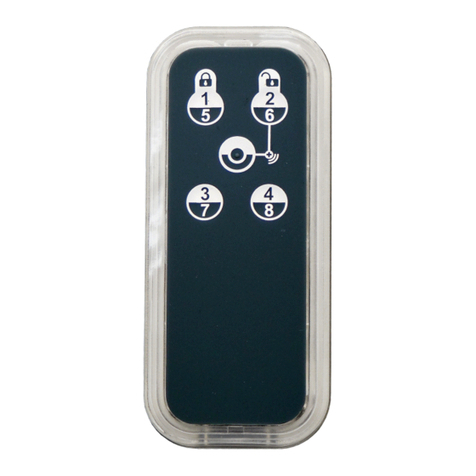
Philio Technology Corporation
Philio Technology Corporation PSR03-A quick start guide
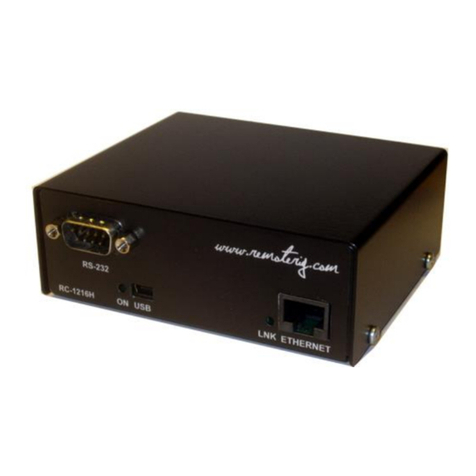
Microbit
Microbit RC-1216H user manual
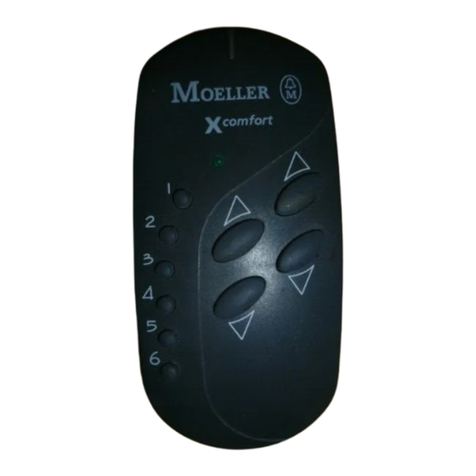
Eaton
Eaton xComfort CHSZ Series Assembly instructions
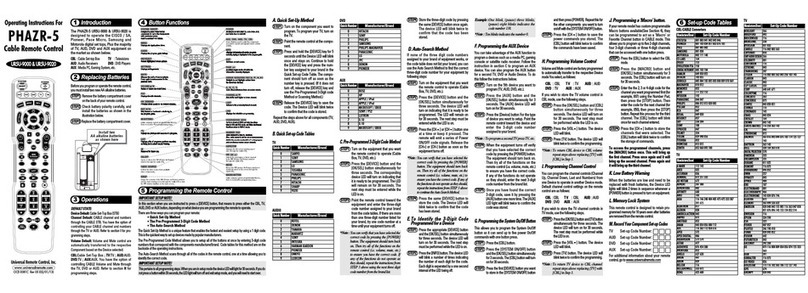
Universal Remote Control
Universal Remote Control PHAZR-5 UR5U-9000 operating instructions
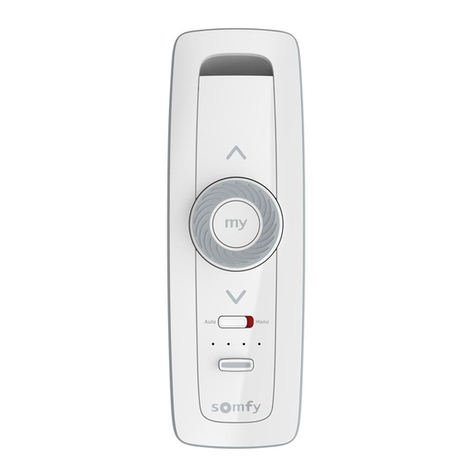
SOMFY
SOMFY SITUO 1 VARIATION Quick installation manual
